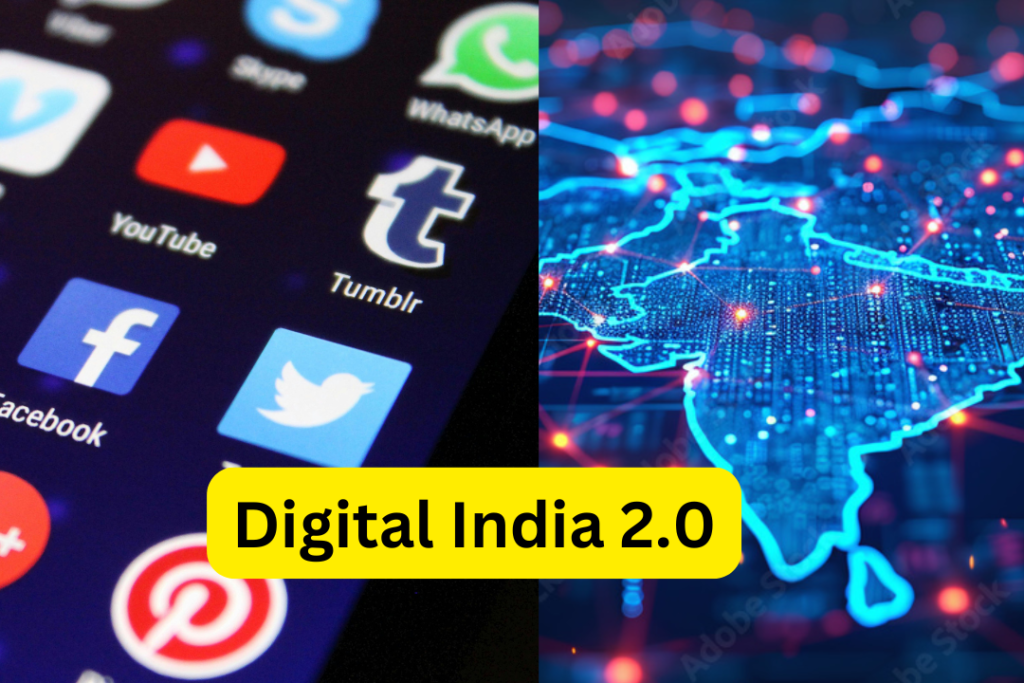
Digital India 2.0
As the flagship program of the Government of India since 2015 transformed the Indian digital landscape, the idea of Digital India 2.0 marks yet another new chapter in building on many of the acquired achievements set to answer changing demands of the digital ecosystem and technological solutions that empower every Indian citizen in seamless, technology-driven manners. It is a harbinger of excellence to develop the digital infrastructure, data-driven governance, and digital literacy to make India the world leader in the digital economy.
Table of Contents
What is Digital India 2.0?
It is basically an upgraded version of the original initiative. It underlines technologies at the emerging edge, data privacy, and cybersecurity to forge digital connectivity. The plan is a comprehensive one for India to achieve the visionary goal of a $1 trillion digital economy by 2025. Digital India 2.0 underlines the intent of increasing influence in all directions through the focus on frontier technological domains like AI, ML, blockchain, and 5G technology to increase the scope and scale of digital services across the country.
Main Objectives of Digital India 2.0
1. Digital Infrastructure and Connectivity Enhancements
The prime objective of Digital India 2.0 is the use of digital infrastructure pan India. Broadband internet connectivity will reach every gram panchayat, which would naturally cover even far-flung places due to digital inclusion. In Digital India 2.0, there is ensured strong e-governance, smart cities, and rural innovation through deploying 5G networks and next-generation internet solutions that underpin the vision of growth in technology .
2. Improvements in Data Protection and Cyber Resilience
In this context, there are slowly finding their feet more people and businesses emerging online to appropriate new basics of data security and cyber resilience. Building a robust framework for cybersecurity which would safeguard and prevent cyber threats while promoting data privacy will find its place under Digital India 2.0. The government has pledged to do this through measures like data encryption, awareness programs, and linking with global cybersecurity organizations under a program meant for securing a digital environment.
3. Digital literacy and inclusion
The Digital India 2.0 will offer a much higher level of digital literacy so that the socio-economic segments can access the same level of digital skill sets. Large-scale upskilling and re-skilling programs for youth, women, and rural populations will be taken up in order to better engage them into the digital economy. This will even involve education institutions and private sector entities in delivering high-quality education to the digital economy.
4. Innovation Hub with Next Generation Technologies
Digital India 2.0 is more focused on emerging technologies, specifically, AI, ML, blockchain, and IoT. Both these emerging technologies will have an enabling environment created for them, and the policies or startup initiatives sponsored by the government will develop, implement, and deploy them in sectors like healthcare, agriculture, education, among others. This is likely to optimize efficiency in the utilization of resources, and significantly contribute to economic growth.
5. E-Governance and Smart Cities
Digital India 2.0 is for e-governance furtherance besides ensuring basic services available to the citizen in a digital environment. The program aims that administrative processes will be more transparent, reducing corruption and bringing accountability. Further support from Digital India 2.0 will be for the Smart Cities Mission to develop smart infrastructure and efficient development of cities in an urban area through digital and data analytics.
Major Initiatives in Digital India 2.0
1. National Broadband Mission (NBM)
National Broadband Mission (NBM) under Digital India 2.0 is to bring credible, high-speed internet connectivity to all households by 2025, with a thrust on fiber expansion and public Wi-Fi networks to make broadening of digital services to the rural population feasible.
2. Scaling Up of India Stack
The India Stack will essentially be Aadhaar, UPI, and DigiLocker-it’s designed as a suite of APIs and digital public goods. Extensions of Digital India 2.0 will be visible. This would mean more applications and services will be built atop this infrastructure while enabling secure digital transactions, easy access to financial services, and efficient delivery of public services.
3. Digital Health and Education
Digital India 2.0 continues this vision of digital platforms for health and education improvement. For example, the Ayushman Bharat Digital Mission plans health ID for every citizen so that the health record can be maintained and accessed digitally. Moreover, the National Education Policy 2020 provides education in the online courses, e-books, and virtual classrooms.
4. National Artificial Intelligence Mission (NAIM)
The government announced the National Artificial Intelligence Mission by realizing the scope of the same. In this, the mission blends AI solutions into the health care, agriculture, and urban development sectors through massive applications of AI technologies for productivity and innovation throughout the country.
5. Rejuvenating the Startup Ecosystem
Digital India 2.0 will carry forward nearly the entire start-up ecosystem that would go in tandem with the provision of financial support, rules simplification, and attraction of investments. It would help in promoting an innovation hub and digital incubator through venture capital that could spur the entrepreneurs to push forward the economy of digitization.
Economic Impact of Digital India 2.0
All these will emanate from expanding the digital economy that will raise the jobs in information technologies, e-commerce, and those other sectors with similar opportunities for millions of Indians. These will significantly raise India’s GDP even jobs will be created, productivity will be enhanced and economies boosted. Digitization in agriculture, manufacturing, and logistics will improve efficiency and reduce operational cost.
Digital payments brought financial inclusion to this move, and even the unbanked can now contribute to the economy.
UPI framework, Aadhaar-enabled payment systems, and mobile banking have accelerated and made easier for the citizen of the country more secure financial transactions accessible to all.
Challenges and Solutions
Digital India 2.0 has very ambitious goals, but in this area, challenges abound.
1. Digital Divide: Internet connectivity though developed is still existing largely in the rural area. There would be a national broadband mission and successful rollout of 5G. The gap would eventually shut down for everybody to have levels of equality.
2. Data Privacy Concerns: Increased digitization always calls for concerns about data privacy and safety issues. Digital India 2.0 will be able to handle such an issue through sterner laws about data privacy and programs that aim to create mass awareness among citizens about safe digital practices.
3. Cyber security threats: A very rapidly increased scale of cyber threats has resulted from the increasing digital infrastructure. Digital India 2.0 works on creating a robust cybersecurity framework, while cybersecurity experts are being trained and global partnerships are established for ensuring safety of citizens and the enterprises.
4. Digital Literacy: The bridging of a digital literacy gap activity is of extreme importance and in greater urgency needs to be performed by rural bodies. Inclusive digital education schemes and other initiations in the development of skill sets will empower all citizenry to take pleasure in digital solutions.
Prospects of Digital India 2.0
Digital India 2.0 will make India a leader in the digitization era in the world. It will happen because the vision behind the initiative of the initiative is to work with emerging technologies, secure data handling, and seamless digital services. Such a vision is expected to make India progress in the ranking of the global economy concerning the digital economy. A $1 trillion digital economy by 2025 is targeted-an accomplishment that would heighten India’s resilience in economic terms while being aligned with sustainable growth.
Along with its own progress, this initiative will be a model for other countries and will act as a great example for others to know how technology can move social and economic environments.
Digital India 2.0 is not only the government project but a great dream that digital empowerment of society enables every citizen to view and learn or to benefit from the digital tools.
Conclusion
The digital transformation of India, or Digital India 2.0 will form the next step on the journey. Developing digital literacy, linking such cutting-edge technology with powerful infrastructure, is going to propel India toward being at the forefront of the world in digitalization.
Having sharp vision, sound implementation, and meeting the changes brought about by technology up to a certain extent, Digital India 2.0 shall now set the digital template for India and make every Indian citizen a part of this extraordinary journey toward a digitally empowered future.
Read more: Digital India 2.0: Shaping India into a Global Digital GiantHow Can Students Manage Their Time 2025
PM – Surya Ghar: Muft Bijli Yojana – A new energy initiative for rural India 2024





